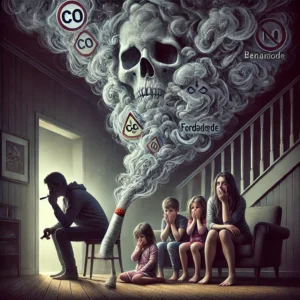ควันบุหรี่ไม่เพียงแต่สร้างอันตรายต่อสุขภาพของผู้สูบเอง แต่ยังส่งผลกระทบอย่างร้ายแรงต่อคนรอบข้างที่ต้องเผชิญกับ “ควันบุหรี่มือสอง” โดยตรง โดยเฉพาะอย่างยิ่งในพื้นที่ปิดหรือที่อากาศถ่ายเทไม่สะดวก ซึ่งควันบุหรี่มือสองนี้มีพิษมากยิ่งกว่าควันที่ผู้สูบสูดผ่านตัวกรองบุหรี่เสียอีก
ควันบุหรี่มือสองคืออะไร?

ควันบุหรี่มือสอง (Secondhand Smoke) คือ ควันที่ปล่อยออกมาจากปลายมวนบุหรี่ที่กำลังเผาไหม้ รวมถึงควันที่ผู้สูบพ่นออกมา ควันเหล่านี้เต็มไปด้วยสารเคมีอันตรายมากกว่า 7,000 ชนิด ซึ่งในจำนวนนี้มีสารก่อมะเร็งมากกว่า 70 ชนิด
สิ่งที่น่ากังวลคือควันที่ปล่อยออกจากปลายมวนบุหรี่ (ควันจากการเผาไหม้) มีสารพิษในระดับที่เข้มข้นกว่า เพราะไม่ได้ผ่านตัวกรองเหมือนควันที่ผู้สูบหายใจเข้าไป
สารพิษในควันบุหรี่มือสอง
ควันบุหรี่มือสองประกอบด้วยสารเคมีที่อันตรายหลายชนิด เช่น
- นิโคติน (Nicotine): สารเสพติดที่ทำให้เกิดการเสพติด
- ทาร์ (Tar): สารเหนียวที่เกาะติดในปอดและทำลายเนื้อเยื่อปอด
- คาร์บอนมอนอกไซด์ (Carbon Monoxide): ก๊าซพิษที่ลดประสิทธิภาพของการขนส่งออกซิเจนในเลือด
- ฟอร์มาลดีไฮด์ (Formaldehyde): สารก่อมะเร็งที่ระคายเคืองต่อดวงตาและระบบทางเดินหายใจ
- เบนซีน (Benzene): สารก่อมะเร็งที่เกี่ยวข้องกับโรคมะเร็งเม็ดเลือด
อันตรายต่อคนรอบข้าง
การสูดดมควันบุหรี่มือสองเป็นการรับสารพิษโดยตรงโดยไม่มีการกรองเหมือนผู้สูบ นี่คือเหตุผลที่ทำให้ควันบุหรี่มือสองอันตรายยิ่งกว่า ผลกระทบที่เกิดขึ้น ได้แก่:
- ความเสี่ยงต่อโรคมะเร็ง
ควันบุหรี่มือสองเป็นสาเหตุสำคัญของ มะเร็งปอด แม้จะไม่ได้สูบบุหรี่เอง คนที่ต้องสัมผัสควันบุหรี่ในระยะยาวมีโอกาสเป็นมะเร็งปอดเพิ่มขึ้น 20-30% - ปัญหาโรคหัวใจและหลอดเลือด
การได้รับควันบุหรี่มือสองเป็นเวลานานเพิ่มความเสี่ยงต่อโรคหัวใจ โรคหลอดเลือดสมอง และความดันโลหิตสูง - ผลกระทบต่อเด็กและหญิงตั้งครรภ์
เด็กที่อยู่ในบ้านที่มีคนสูบบุหรี่มีโอกาสเป็นโรคระบบทางเดินหายใจ เช่น หอบหืดและปอดอักเสบ ส่วนหญิงตั้งครรภ์ที่ได้รับควันบุหรี่มือสองอาจเกิดภาวะแท้งหรือเด็กเกิดมามีน้ำหนักตัวน้อย
ป้องกันควันบุหรี่มือสองได้อย่างไร?
- หลีกเลี่ยงพื้นที่ที่มีการสูบบุหรี่ เช่น ร้านอาหารหรือสถานที่สาธารณะ
- สนับสนุนกฎหมายห้ามสูบบุหรี่ในที่สาธารณะ เพื่อปกป้องคนรอบข้าง
- รณรงค์ให้เลิกสูบบุหรี่ ทั้งเพื่อสุขภาพของตนเองและคนรอบข้าง
สรุป:
ควันบุหรี่มือสองเป็นภัยเงียบที่ไม่ควรมองข้าม คนที่ไม่ได้สูบบุหรี่แต่ต้องอยู่ใกล้ผู้สูบบุหรี่เป็นประจำมีโอกาสได้รับสารพิษที่เข้มข้นกว่า ซึ่งเพิ่มความเสี่ยงต่อโรคมะเร็งและโรคร้ายแรงอื่น ๆ การตระหนักถึงผลกระทบและป้องกันตนเองจากควันบุหรี่มือสองจึงเป็นสิ่งจำเป็น เพื่อสร้างสภาพแวดล้อมที่ปลอดบุหรี่และปลอดภัยสำหรับทุกคน
Cigarette smoke doesn’t just harm smokers; it also poses a severe threat to those around them through secondhand smoke, especially in enclosed or poorly ventilated spaces. Surprisingly, secondhand smoke can be more toxic than the smoke inhaled by the smoker due to the absence of a filter. This makes it a silent killer for bystanders.
What is Secondhand Smoke?
Secondhand smoke refers to the combination of:
- Smoke released from the burning end of a cigarette (sidestream smoke).
- Smoke exhaled by the smoker (mainstream smoke).
This smoke contains over 7,000 chemicals, of which more than 70 are known carcinogens. Sidestream smoke, coming directly from the burning cigarette, is especially dangerous because it hasn’t passed through the cigarette’s filter, leading to higher concentrations of toxic substances.
Toxic Chemicals in Secondhand Smoke
Secondhand smoke is a cocktail of harmful chemicals, including:
- Nicotine: The addictive substance in tobacco.
- Tar: A sticky residue that damages lung tissue.
- Carbon Monoxide: A poisonous gas that reduces oxygen levels in the blood.
- Formaldehyde: A known carcinogen that irritates the eyes and respiratory system.
- Benzene: A cancer-causing chemical linked to leukemia.
Why Is It More Dangerous to Bystanders?
Non-smokers exposed to secondhand smoke breathe in these toxic substances directly, without the filter that smokers use. This makes secondhand smoke even more harmful. The health effects include:
- Increased Cancer Risk
Secondhand smoke is a leading cause of lung cancer in non-smokers. Long-term exposure increases the risk by 20-30%, even for those who have never smoked. - Heart and Cardiovascular Diseases
Prolonged exposure heightens the risk of heart disease, stroke, and high blood pressure in non-smokers. - Impact on Children and Pregnant Women
Children in households with smokers are more likely to suffer from respiratory issues like asthma and pneumonia. Pregnant women exposed to secondhand smoke face risks such as miscarriage, low birth weight, and premature delivery.
How to Protect Against Secondhand Smoke
- Avoid Areas with Smoking: Stay away from environments where smoking is permitted, such as some restaurants or public spaces.
- Support Smoke-Free Policies: Advocate for laws that ban smoking in public areas to protect non-smokers.
- Encourage Smokers to Quit: Help loved ones quit smoking to improve their health and protect those around them.
Conclusion
Secondhand smoke is a silent but deadly health hazard, especially for non-smokers. Being exposed to it can lead to serious diseases like cancer, heart problems, and respiratory conditions. Raising awareness about its dangers and taking steps to reduce exposure is crucial for creating a smoke-free, healthier environment for everyone.